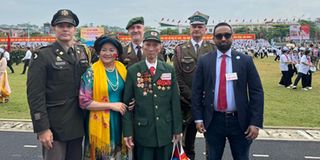From conflict to cooperation: Vietnam’s inspiring journey

Dr. Mohamed Osman Mohamoud with Vietnamese officials.
My first trip to Vietnam, a country often depicted through war movies and stories, was truly eye-opening. I was honored to be invited by the Central Committee of the Communist Party of Vietnam, the National Assembly, the State President, the Government, the Vietnam Fatherland Front Central Committee, and the Committee of Dien Bien Province.
This invitation allowed me to attend the 70th anniversary parade commemorating the Battle of Dien Bien Phu on May 7, 2024. During this event, I witnessed a pivotal moment in history that dramatically reshaped Vietnam and its colonial rulers.
The French Indochina War, which began in 1946, culminated in the decisive defeat of the French at Dien Bien Phu in May 1954, ending French colonial rule in Vietnam. This battle marked the beginning of a long and arduous journey towards reconciliation and rebuilding.
As an academic deeply interested in peace and conflict transformation, I was eager to understand how these historical conflicts had evolved over the decades. At the parade, I met a French veteran who shared his reflections on the war and its aftermath. ‘It is not strange,’ he said, ‘we also fought with the Germans, and now we are friends, making the EU one of the largest and most successful common markets.’ His words highlighted the potential for former enemies to become partners in peace and progress.
Military attaches
The parade, featuring 12,000 participants, showcased army personnel, militia members, police officers, veterans, workers, and others. Despite the heavy rain, the crowd's endurance and enthusiasm was palpable. The Prime Minister, Pham Minh Chinh, handed out medals, emphasizing the significance of the Dien Bien Phu victory in ending French colonialism.
The presence of French veterans and military attaches at the event symbolized a remarkable transformation. Both Vietnamese and French participants seemed to have reconciled with the past, focusing instead on a future of cooperation and mutual respect.
As an African, I found this particularly striking. In Africa, wars are often either used to polarise people or avoided in public discourse. Yet here, in Vietnam, I witnessed true healing and reconciliation. This spirit of reconciliation extended beyond the French. The United States, which had a history of brutal conflict with Vietnam during the Vietnam War, also participated in the event.
The Vietnam War, which saw heavy US intervention in the mid-1960s, caused immense destruction and loss of life. However, following the cease-fire agreement in 1973 and the eventual withdrawal of U.S. troops, the two nations began a slow but steady journey towards rebuilding their relationship.
This year marks the 11th anniversary of the US-Vietnam Comprehensive Partnership, initiated by Presidents Obama and Sang in 2013. Celebrating this milestone, both nations look forward to expanding their collaboration. Since establishing diplomatic relations in 1995, the US -Vietnam partnership has grown rapidly, founded on mutual trust and a shared desire to overcome the legacies of war. This relationship now encompasses economic, political, and security ties, as well as people-to-people connections, science and technology, health, climate, energy, education, and human rights. The partnership aims to ensure an open, connected, prosperous, resilient, and peaceful Indo-Pacific region.
Trade between the United States and Vietnam has grown significantly over the past three decades. From almost no economic ties when they established diplomatic relations 28 years ago, bilateral trade reached over $138 billion in 2022. Vietnam's exports to the US amounted to $118.92 billion in 2023, while U.S. exports to Vietnam increased at an annualised rate of 113% over the last five years. This economic cooperation is a testament to how former adversaries can transform their relationship into one of mutual benefit.
Conflict
The history of conflict between Vietnam, France, and the United States serves as a powerful reminder of the potential for reconciliation and cooperation. The First Indochina War, fought between France and the Viet Minh from 1946 to 1954, ended with the French defeat at Dien Bien Phu. The Geneva Accords of 1954 temporarily divided Vietnam into two military zones and set the stage for the eventual reunification of the country in 1976.
The American role in the Indochina crisis evolved into heavy US intervention in the Vietnam War. Despite the war's devastation, the relationship between the US and Vietnam has been transformed through diplomacy, economic ties, and mutual respect. This transformation underscores the importance of negotiation and peace talks in resolving conflicts.
Reflecting on my experiences in Vietnam, I can’t help but draw parallels with my own country, Somalia. Somalia, like Vietnam, has endured decades of conflict and strife. However, Somalia is now on the path to peace, integration, and the peaceful settlement of its internal and external disputes. The case of Vietnam illustrates that military power alone cannot achieve lasting peace; instead, negotiation and diplomacy must be the focus.
In a world increasingly polarised both domestically and internationally, we must learn from Vietnam's history of war and peace. The fruits of reconciliation, as seen in Vietnam, can serve as a beacon for other nations facing similar challenges.
During my visit, I explored Hanoi, the capital city of Vietnam. I was amazed by the transformation and rapid development of its infrastructure. Hanoi is not just a capital but a center of many struggles and a place that holds a special place in the hearts of the Vietnamese. The city's blend of ancient traditions and modern advancements showcases its resilience and adaptability.
Continuing my journey, I visited Saigon, now known as Ho Chi Minh City. This bustling metropolis, with a population of around 10 million in 2023, is defined by its intricate network of rivers and canals, with the Saigon River being the largest. Before its fall, Saigon was the capital of the southern half of Vietnam, known as the Republic of Vietnam. In 1976, following the establishment of the unified communist Socialist Republic of Vietnam, Saigon was renamed Ho Chi Minh City in honor of the late communist leader. This city's historical significance and its portrayal in Hollywood films add to its allure, making it a fascinating place to witness Vietnam's journey from conflict to unity.
While in Ho Chi Minh City, I visited the Cu Chi Tunnels. Though I was born and grew up in Mogadishu and have experienced the horrors and destruction of war, Somalia did not have tunnels like those in Vietnam. The Cu Chi Tunnels, located in the Cu Chi District of Ho Chi Minh City, are an immense network of hand-carved tunnels. These tunnels, preserved by the Vietnamese government and turned into a memorial park, are some of the most horrifying remnants of the Vietnam War. They provided underground shelter and played a crucial role during combat operations, serving as a base for Communist forces. Visiting these tunnels offers a stark reminder of the war’s intensity and the resilience of those who lived through it.
Division
Vietnam's experience serves as a beacon of hope for other nations grappling with division and conflict. Somalia, too, has faced its share of challenges. Once divided by colonial powers and later torn apart by civil war, Somalia has struggled to find stability and unity.
However, just as Vietnam overcame its divisions to emerge as a strong, unified nation, Somalia can do the same. With a commitment to peace, governance, and development, Somalia has the potential to rise above its past conflicts. The country’s rich history, cultural heritage, and resilient spirit are powerful foundations upon which to build a united and prosperous future.
Though modern Somalia distanced itself from the communist and socialist world in 1991 following the collapse of its single-party regime, echoes of the past still linger. The parades and festivals under Somalia’s former scientific socialist military regime bore a resemblance
to those of communist parties in East Asia and other regions where communism persists. However, Somalia has now embarked on a grassroots-led democratic process, which aims to integrate traditional political institutions with modern democratic practices.
Today, Somalia is focusing on implementing constitutionalism and multiparty democracy based on Islamic and Somali principles of social development, equality, tolerance, peaceful coexistence, and justice. The country is transitioning from a clan-based political power-sharing system to a universal suffrage or ‘one person, one vote’ approach, marking a significant change in its political landscape.
Vietnam's journey reminds us that even in the face of seemingly insurmountable challenges, unity and resilience can prevail. As Somalia continues its path toward reconciliation and nation-building, the story of Vietnam offers a powerful example of what can be achieved with determination and a collective vision for a better future.
As Somalia gets ready to celebrate its centennial year in 2060, it is in the process of finalizing its draft constitution and developing the Centennial Vision 2060. This vision will offer guidance for seven Medium-Term Plans (MTP 1–7) from 2024 to 2060 aimed at achieving a peaceful, stable, and prosperous Somalia.
Dr. Mohamed Osman Mohamoud is the Regional Representative for the University for Peace covering Middle East, Eastern and Southern Africa for the Africa Regional Programme.



